Underwater Noise Measurements around a Tidal Turbine in a Busy Port Setting
Abstract
:1. Introduction
2. Materials and Methods
2.1. Site Description
2.2. Turbine
2.3. Drifting Hydrophones
2.4. Data Collection
2.5. Data Processing and Analysis
3. Results
4. Discussion
Author Contributions
Funding
Data Availability Statement
Acknowledgments
Conflicts of Interest
References
- Kilcher, L.; Fogarty, M.; Lawson, M. Marine Energy in the United States: An Overview of Opportunities; National Renewable Energy Laboratory: Golden, CO, USA, 2021. [CrossRef]
- Slabbekoorn, H.; Bouton, N. Soundscape orientation: A new field in need of sound investigation. Anim. Behav. 2008, 4, e5–e8. [Google Scholar] [CrossRef]
- Pijanowski, B.C.; Villanueva-Rivera, L.J.; Dumyahn, S.L.; Farina, A.; Krause, B.L.; Napoletano, B.M.; Gage, S.H.; Pieretti, N. Soundscape ecology: The science of sound in the landscape. BioScience 2011, 61, 203–216. [Google Scholar] [CrossRef] [Green Version]
- Shannon, G.; McKenna, M.F.; Angeloni, L.M.; Crooks, K.R.; Fristrup, K.M.; Brown, E.; Wittemyer, G.; Warner, K.A.; Nelson, M.D.; White, C.; et al. A synthesis of two decades of research documenting the effects of noise on wildlife. Biol. Rev. 2016, 91, 982–1005. [Google Scholar] [CrossRef] [PubMed]
- Peng, C.; Zhao, X.; Liu, G. Noise in the sea and its impacts on marine organisms. Int. J. Environ. Res. Public Health 2015, 12, 12304–12323. [Google Scholar] [CrossRef] [PubMed] [Green Version]
- Erbe, C. Effects of underwater noise on marine mammals. In The Effects of Noise on Aquatic Life; Springer: Berlin/Heidelberg, Germany, 2012; pp. 17–22. [Google Scholar]
- Copping, A.E.; Hemery, L.G.; Overhus, D.M.; Garavelli, L.; Freeman, M.C.; Whiting, J.M.; Gorton, A.M.; Farr, H.K.; Rose, D.J.; Tugade, L.G. Potential environmental effects of marine renewable energy development—The state of the science. J. Mar. Sci. Eng. 2020, 8, 879. [Google Scholar] [CrossRef]
- National Marine Fisheries Service. 2018 Revision to: Technical Guidance for Assessing the Effects of Anthropogenic Sound on Marine Mammal Hearing (Version 2.0): Underwater Thresholds for Onset of Permanent and Temporary Threshold Shifts; National Oceanic and Atmospheric Administration: Washington, DC, USA, 2018.
- Popper, A.N.; Hawkins, A.D.; Fay, R.R.; Mann, D.A.; Bartol, S.; Carlson, T.J.; Tavolga, W.N.; Coomabs, S.; Ellison, W.T.; Gentry, R.L.; et al. sound Exposure guidelines. In ASA S3/SC1. 4 TR-2014 Sound Exposure Guidelines for Fishes and Sea Turtles: A Technical Report Prepared by ANSI-Accredited Standards Committee S3/SC1 and Registered with ANSI; Springer: Berlin/Heidelberg, Germany, 2014; pp. 33–51. [Google Scholar]
- Polagye, B. Challenges to characterization of sound produced by marine energy converters. In Marine Renewable Energy; Springer: Berlin/Heidelberg, Germany, 2017; pp. 323–332. [Google Scholar]
- Wilson, B.; Lepper, P.A.; Carter, C.; Robinson, S.P. Rethinking underwater sound-recording methods to work at tidal-stream and wave-energy sites. In Marine Renewable Energy Technology and Environmental Interactions; Springer: Berlin/Heidelberg, Germany, 2014; pp. 111–126. [Google Scholar]
- Risch, D.; van Geel, N.; Gillespie, D.; Wilson, B. Characterisation of underwater operational sound of a tidal stream turbine. J. Acoust. Soc. Am. 2020, 147, 2547–2555. [Google Scholar] [CrossRef] [PubMed] [Green Version]
- Schmitt, P.; Elsaesser, B.; Coffin, M.; Hood, J.; Starzmann, R. Field testing a full-scale tidal turbine part 3: Acoustic characteristics. In Proceedings of the European Wave and Tidal Energy Conference 2015, Nantes, France, 6–11 September 2015. [Google Scholar]
- Polagye, B. Acoustic characterization of a hydrokinetic turbine. In Proceedings of the 11th European Wave and Tidal Energy Conference, Nantes, France, 6–11 September 2015. [Google Scholar]
- Lossent, J.; Lejart, M.; Folegot, T.; Clorennec, D.; Di Iorio, L.; Gervaise, C. Underwater operational noise level emitted by a tidal current turbine and its potential impact on marine fauna. Mar. Pollut. Bull. 2018, 131, 323–334. [Google Scholar] [CrossRef] [PubMed]
- Bassett, C.; Thomson, J.; Dahl, P.H.; Polagye, B. Flow-noise and turbulence in two tidal channels. J. Acoust. Soc. Am. 2014, 135, 1764–1774. [Google Scholar] [CrossRef] [PubMed] [Green Version]
- Eaves, S.L.; Staines, G.; Harker-Klimeš, G.; Pinza, M.; Geerlofs, S. Triton Field Trials: Promoting Consistent Environmental Monitoring Methodologies for Marine Energy Sites. J. Mar. Sci. Eng. 2022, 10, 177. [Google Scholar] [CrossRef]
- University of New Hampshire. Portsmouth Memorial Bridge: The Living Bridge. Available online: https://livingbridge.unh.edu/ (accessed on 10 December 2021).
- IEC/TS 62600-40; Acoustic Characterization of Marine Energy Converters. International Electrotechnical Commisssion: Geneva, Switzerland, 2019; p. 44. Available online: https://webstore.iec.ch/publication/31031 (accessed on 8 August 2019).
- Chancey, K. Assessment of the Localized Flow and Tidal Energy Conversion System at an Estuarine Bridge. Master’s Thesis, University of New Hampshire, Durham, NH, USA, 2019; p. 135. [Google Scholar]
- Gagnon, I. A Hydrokinetic Turbine Deployment System for Use at Bridges with the Memorial Bridge as a Case Study. Master’s Thesis, University of New Hampshire, Durham, NH, USA, 2018; p. 212. [Google Scholar]
- Chang, G.; Harker-Klimeš, G.; Raghukumar, K.; Polagye, B.; Haxel, J.; Joslin, J.; Staines, G.; Spada, F. Clearing a Path to Commercialization of Marine Renewable Energy Technologies Through Public–Private Collaboration. Front. Mar. Sci. 2021, 8, 1180. [Google Scholar] [CrossRef]
- Polagye, B.; Noe, J.; Murphy, P. Flow-noise mitigation for drifting acoustic measurements in current-dominated environments. In Proceedings of the 6th Marine Energy Technology Symposium, Washington, DC, USA, 30 April–2 May 2018. [Google Scholar]
- Deng, Z.; Weiland, M.; Carlson, T.; Eppard, M.B. Design and instrumentation of a measurement and calibration system for an acoustic telemetry system. Sensors 2010, 10, 3090–3099. [Google Scholar] [CrossRef] [PubMed]
- NOAA National Geodetic Survey. User Friendly CORS (UFCORS)—Continuously Operating Reference Station Network; NOAA National Geodetic Survey: Silver Spring, MD, USA, 2021.
- Mellinger, D.K. Ishmael 1.0 User’s Guide; NOAA Technical Memorandum OAR PMEL: Seattle, WA, USA, 2001; Volume 120.
- Tougaard, J. Underwater Noise from a Wave Energy Converter Is Unlikely to Affect Marine Mammals. PLoS ONE 2015, 10, e0132391. [Google Scholar] [CrossRef]
- Bevelhimer, M.S.; Deng, Z.D.; Scherelis, C. Characterizing large river sounds: Providing context for understanding the environmental effects of noise produced by hydrokinetic turbines. J. Acoust. Soc. Am. 2016, 139, 85–92. [Google Scholar] [CrossRef] [PubMed]
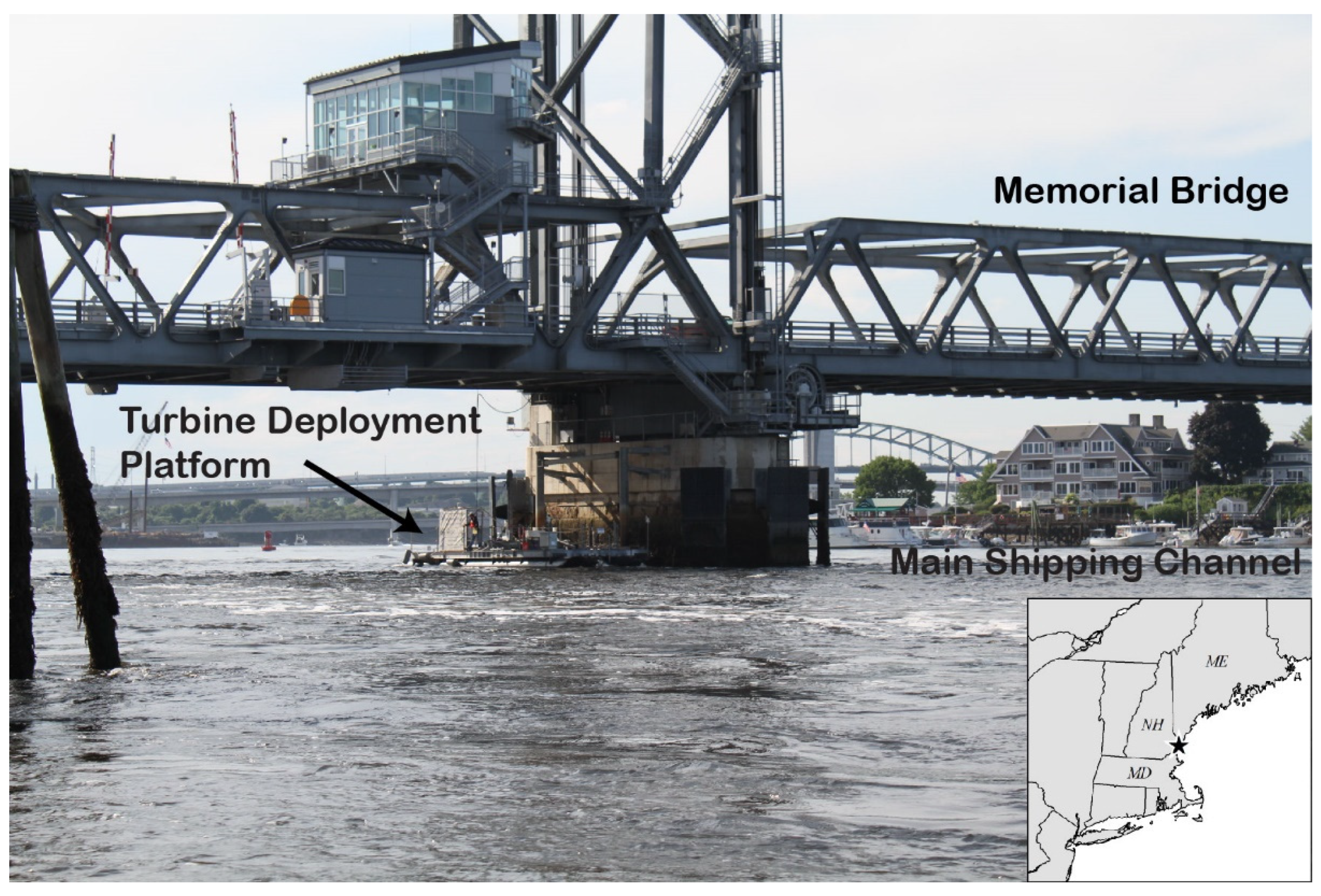
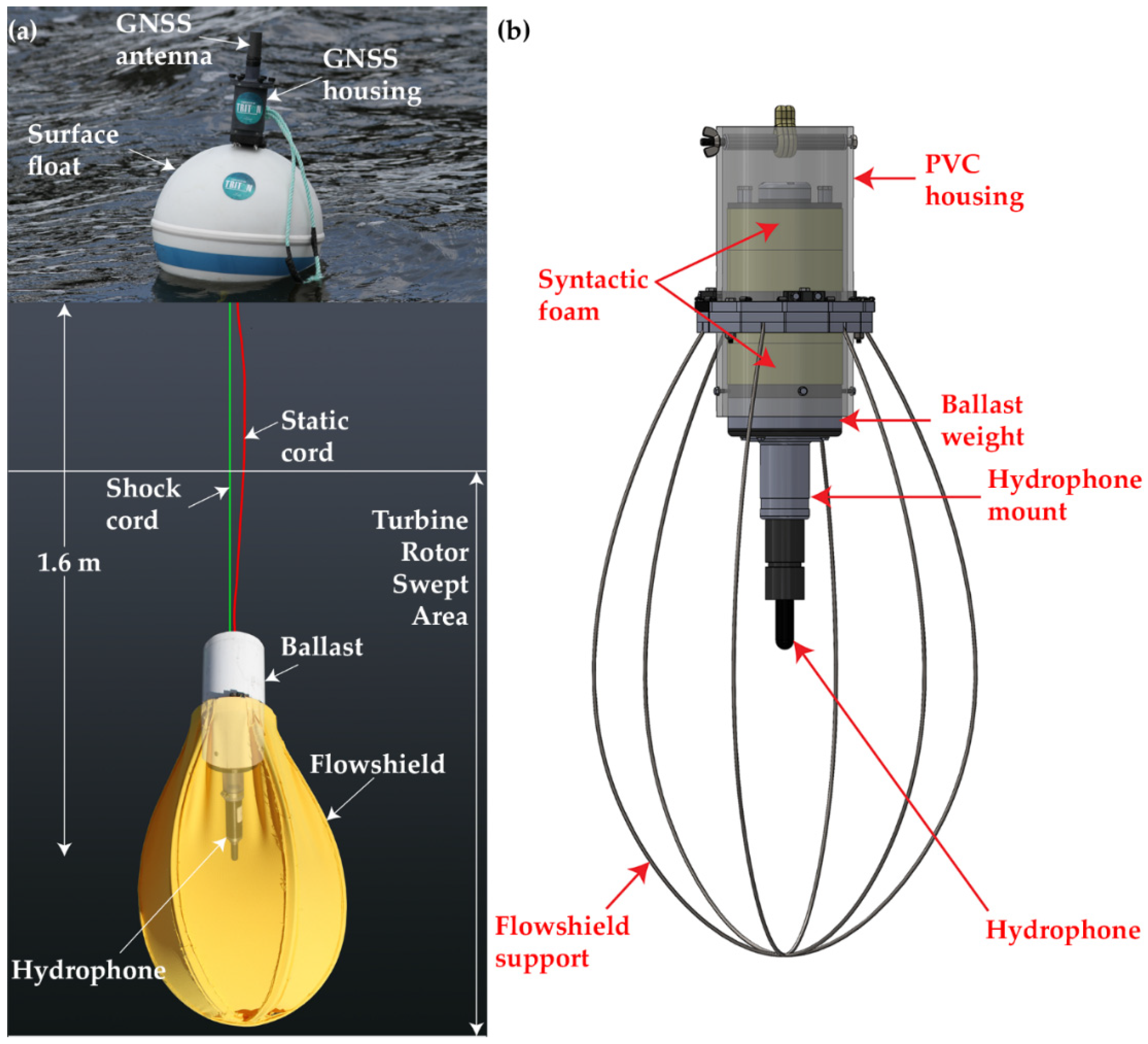
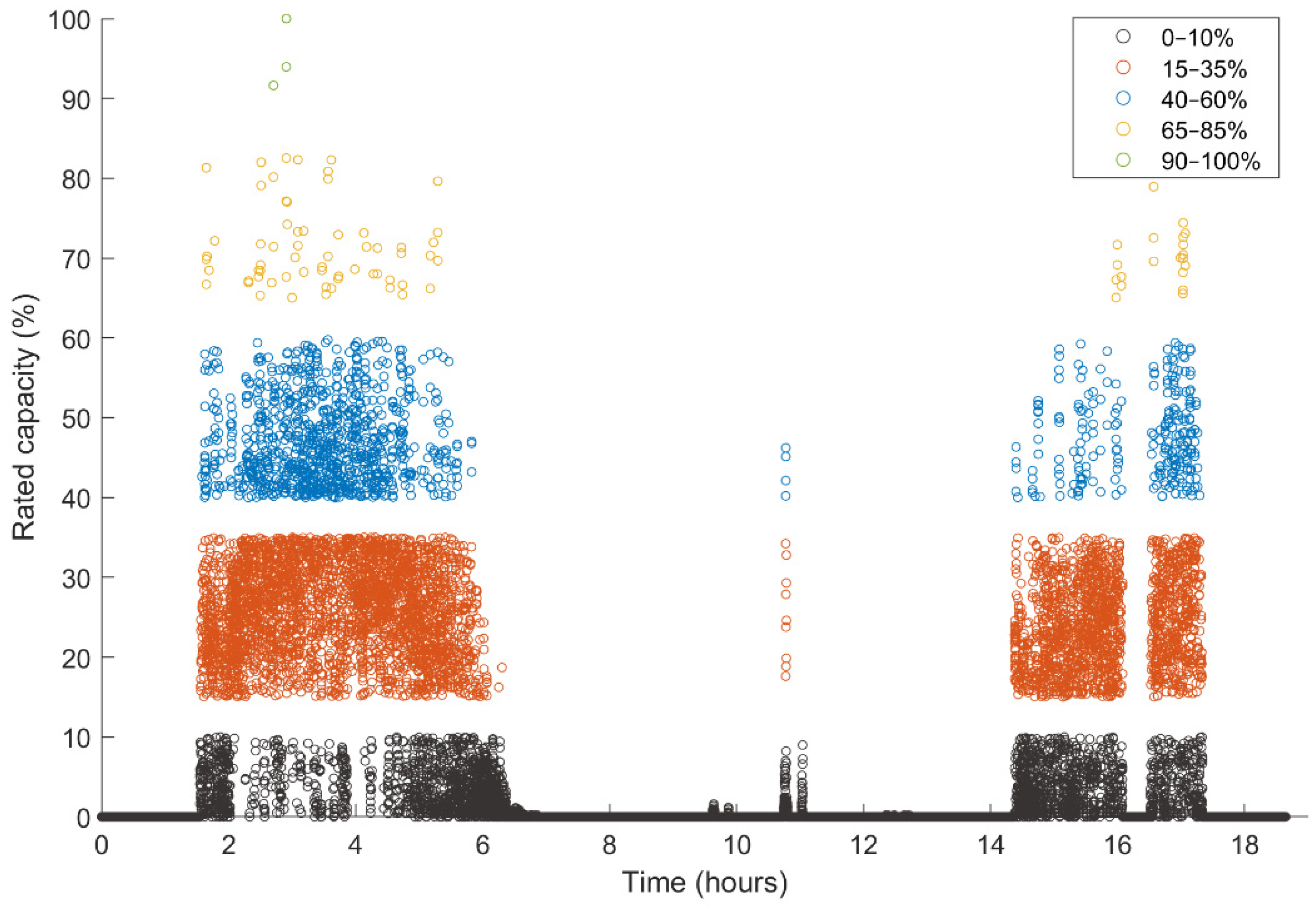
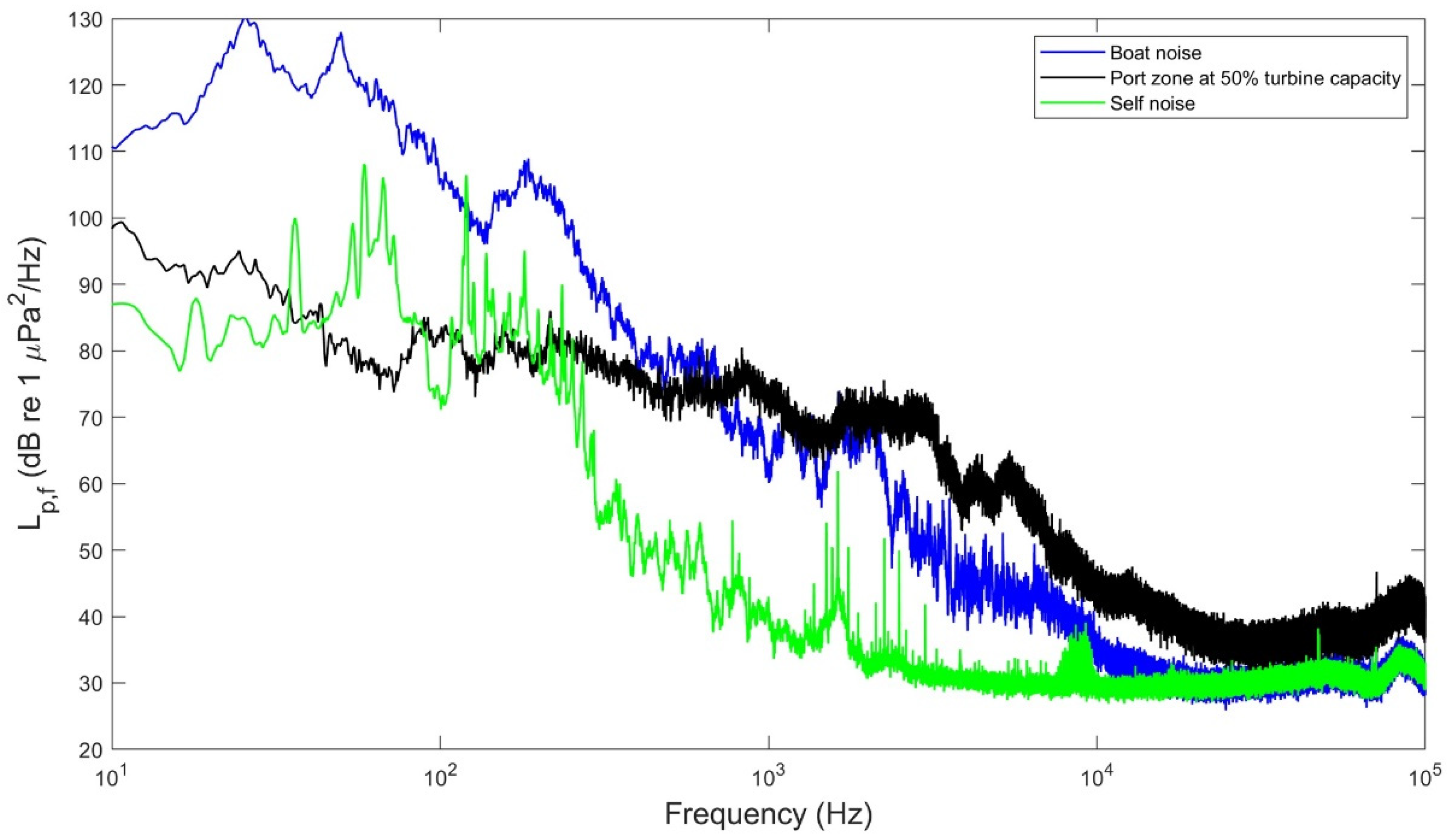
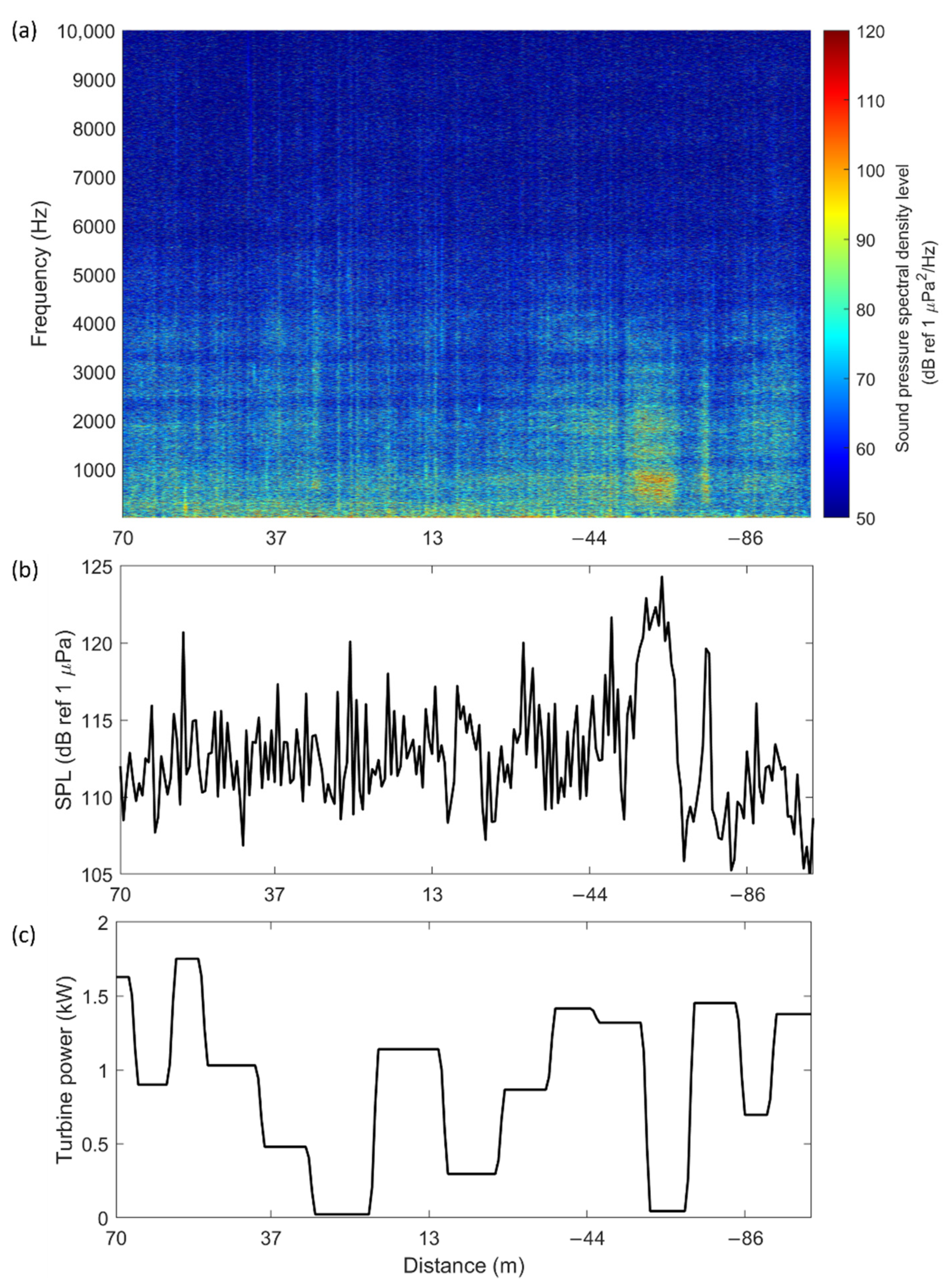
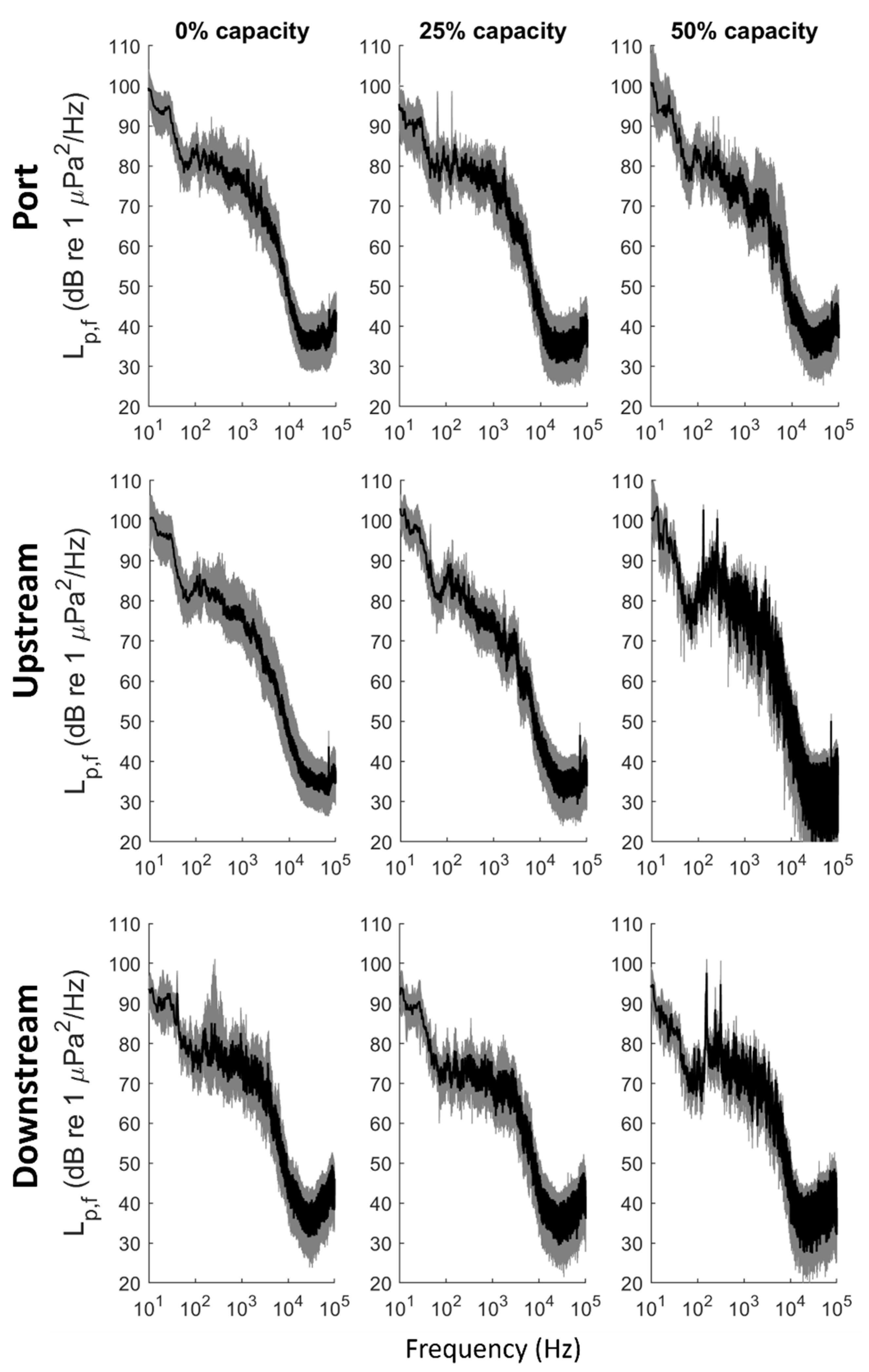

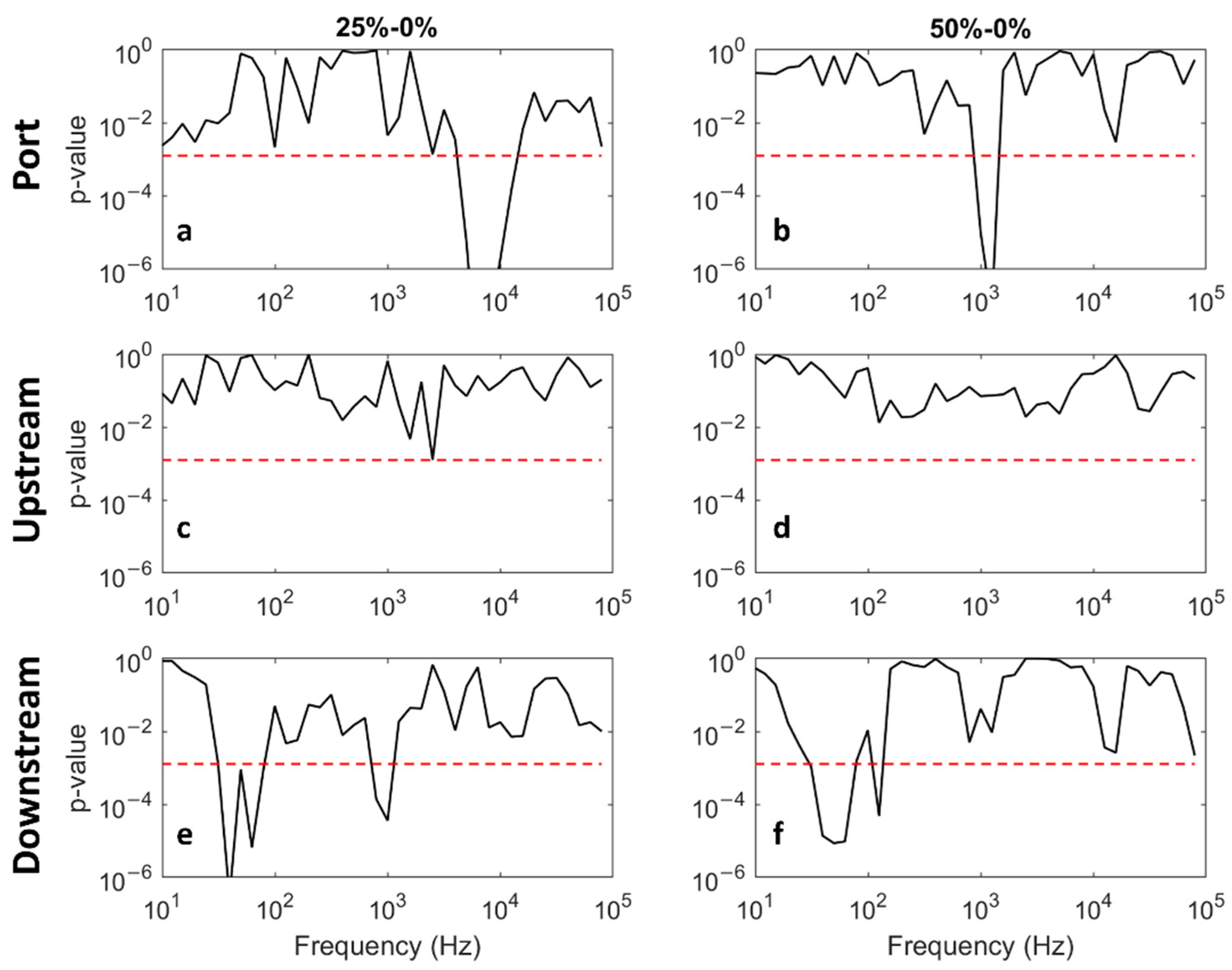
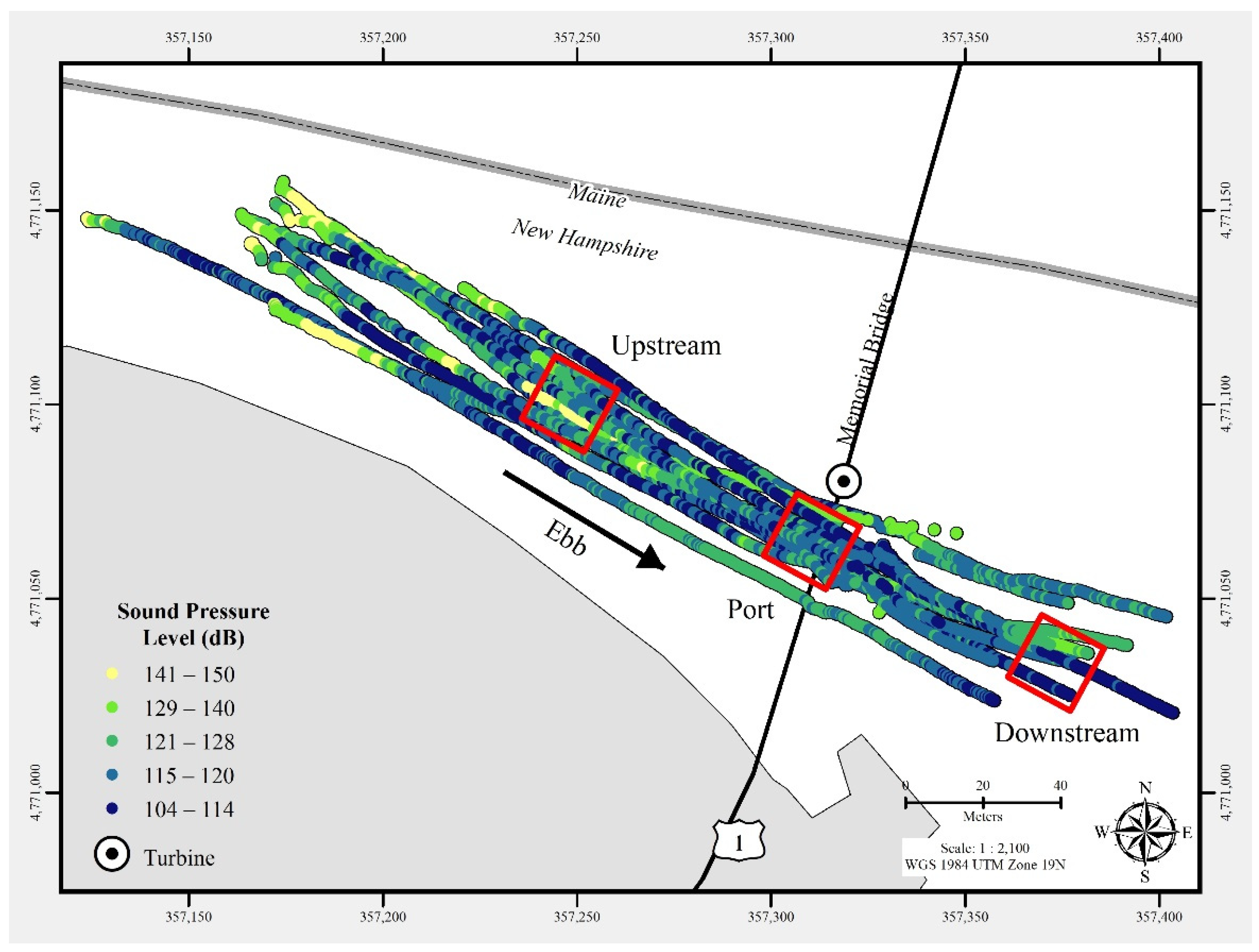
| Zone | 0% Capacity | 25% Capacity | 50% Capacity |
|---|---|---|---|
| Port | 117.7 (N = 134, std = 5.73) | 116.4 (N = 34, std = 4.82) | 116.3 (N = 35, std = 7.56) |
| Upstream | 118.5 (N = 146, std = 8.95) | 116.1 (N = 34, std = 3.46) | 119.4 dB (N = 12, std = 1.75) |
| Downstream | 120.6 (N = 25, std = 4.48) | 111.8 (N = 33, std = 5.38) | 113.0 (N = 12, std = 1.74) |
| Turbine | Capacity | SPL (dB re 1 µPa) | Frequency (Hz) | Range (m) | Reference |
|---|---|---|---|---|---|
| RivGen | 35 kW | 137 dB | 50–1000 Hz | 1–2 m | [14] |
| Atlantis AR1500 | 1.5 MW | 136 dB | 100–1000 Hz | <100 m | [12] |
| TidGen | 150 kW | 121 dB | 10–15 kHz | 21 m | [28] |
| Envirogen 025 | 25 kW | 116 dB | 10–100 kHz | 10–40 m | This study |
Publisher’s Note: MDPI stays neutral with regard to jurisdictional claims in published maps and institutional affiliations. |
© 2022 by the authors. Licensee MDPI, Basel, Switzerland. This article is an open access article distributed under the terms and conditions of the Creative Commons Attribution (CC BY) license (https://creativecommons.org/licenses/by/4.0/).
Share and Cite
Haxel, J.; Zang, X.; Martinez, J.; Polagye, B.; Staines, G.; Deng, Z.D.; Wosnik, M.; O’Byrne, P. Underwater Noise Measurements around a Tidal Turbine in a Busy Port Setting. J. Mar. Sci. Eng. 2022, 10, 632. https://doi.org/10.3390/jmse10050632
Haxel J, Zang X, Martinez J, Polagye B, Staines G, Deng ZD, Wosnik M, O’Byrne P. Underwater Noise Measurements around a Tidal Turbine in a Busy Port Setting. Journal of Marine Science and Engineering. 2022; 10(5):632. https://doi.org/10.3390/jmse10050632
Chicago/Turabian StyleHaxel, Joseph, Xiaoqin Zang, Jayson Martinez, Brian Polagye, Garrett Staines, Zhiqun Daniel Deng, Martin Wosnik, and Patrick O’Byrne. 2022. "Underwater Noise Measurements around a Tidal Turbine in a Busy Port Setting" Journal of Marine Science and Engineering 10, no. 5: 632. https://doi.org/10.3390/jmse10050632







